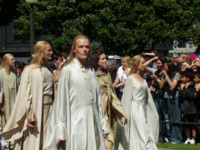Wellington
Elizabeth Julian RSM
7 November 2012
 The elves from Peter Jackson’s The Lord of the Rings on the red carpet for the Wellington launch of the third in the series, Return of the King.
The elves from Peter Jackson’s The Lord of the Rings on the red carpet for the Wellington launch of the third in the series, Return of the King.
Dr Elizabeth Julian rsm offered this analysis of the spirituality of place in Peter Jackson’s The Lord of the Rings trilogy for publication in the December. 2003 issue of Wel-Com. The world premiere of Peter Jackson’s The Hobbit: An Unexpected Journey takes place in Wellington on November 28, 2012. For more about Wel-Com’s 300 issues, click here.
Wellington on a great day makes us feel proud to be Wellingtonians – to see our city and its environs at their sparkling best. But it does more than that.
The amazing urban and rural landscapes we inhabit throughout the entire archdiocese inspire and shape both our identity and our spirituality.
Many of our artists, writers, photographers and poets demonstrate so clearly how the landscape is the geography of our imagination.
It’s our metanarrative or ‘great story’. We’re culturally conditioned by it and it exerts a lasting and mysterious power over us. As such landscape, or place, gives us a particular context for our spirituality.
English theologian Rosemary Haughton highlights the connection between place and spirituality in some telling observations about the concept of place in Tolkien’s epic The Lord of the Rings [Rosemary Haughton, ‘Religious Experience and Religious Commitment’ The Way Supplement 1998/92-39-52]
Her conclusions are important for our spirituality in the archdiocese at this time when Lord of the Rings fever is everywhere. I think we can apply what Haughton says about the book to what Peter Jackson has achieved in the film version. Haughton notes that many reasons have been given for the popularity of the book but the one that particularly strikes her is that Tolkien has created a vast place, Middle Earth.
This place contains many different kinds of landscapes, peoples, climates, flora. All of these elements are interrelated.
Those of us who have witnessed what Jackson has done to recreate Middle Earth in the first two films have been overwhelmed at the transformation of our very own landscape.
To walk out of the Embassy theatre and look up to the pine trees on Mt Victoria and realise you have just seen them on the large screen is an incredible experience.
Jackson’s attention to detail, like Tolkien’s, has created such local distinctiveness that we feel we have been there, that we know it from the inside.
And we do know it, for it is not just Middle Earth, it is our place:
- Pelennor Fields is in Queen Elizabeth Park, Paekakariki
- Rivendell is in the Kaitoke Regional Park
- Bree is in Seatoun; parts of Hobbiton Woods are on Mt Victoria and in the Otaki Gorge
- the Great River Anduin is the Hutt River, Helm’s Deep is at the bottom of Haywards Hill
- Bag End (Bilbo Baggins’ home in the Shire) is in the Wairarapa.
Haughton points out that all the characters in Tolkien’s epic, including those who have to travel great distances from their place of origin, are profoundly influenced by their experience of place.
These characters ‘… are the product of a culture – a spirituality – nurtured and shaped by experience of place, which is both their strength, their joy and at times, their grief’.
The places themselves almost have distinct personalities to which the people who inhabit them are intimately connected.
Haughton claims that The Lord of the Rings is about place as sacrament. For her it is place that makes sense of and integrates the epic’s great variety of spiritual experiences and personal and communal commitments.
Thus, place and spirituality are inextricably linked. Our spirituality is rooted in a particular place. Our particular place is here in the archdiocese and our spirituality is nurtured and shaped by the way we experience this place.
It is here where our spiritual experiences of wonder, awe, mystery, delight, tragedy, joy, etc and our personal and communal commitments happen.
May our experience of Lord of the Rings: The Return of the King and our experience of place this summer nourish our spirituality by reminding us of the connection between place and spirituality.
Let’s claim an absolutely, positively, creatively, Middle Earth, Wellington spirituality. We’re on holy ground. Come on Wellingtonians, take off your shoes – Peter Jackson does!